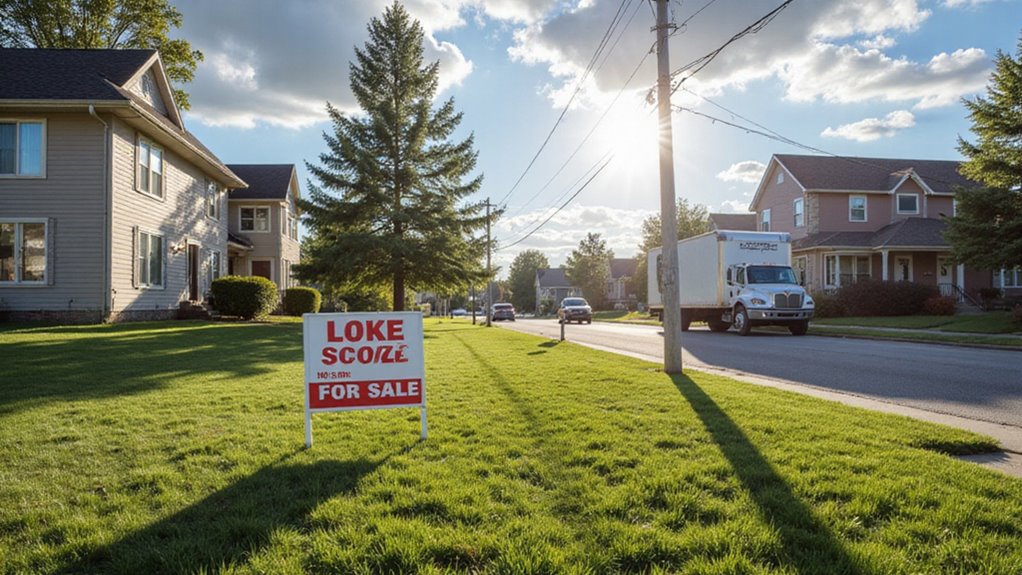Moving to a new city is stressful enough. Selling your house quickly and at a good price adds another layer of pressure. Market conditions can change fast and make the process even harder.
You may worry about high interest rates, too many homes for sale, or a slow local economy. If you ignore these factors, you could lose money or get stuck with your house longer than planned. These challenges can delay your relocation and cost you time and cash.
Yes, market conditions can make or break your plans when selling a house for relocation. You should watch key trends and adjust your selling strategy as needed. This way, you can avoid costly mistakes and move on time.
This blog will guide you through current market conditions and help you sell your house smoothly before your relocation.
Key Takeaways
- Market type (buyer’s or seller’s) directly influences sale speed, pricing, and negotiation power when relocating.
- High interest rates can reduce buyer demand, making it harder to sell quickly for relocation purposes.
- Local economic trends and job growth affect home values and the ease of selling before a move.
- Timing your sale during peak seasons or favorable market conditions can maximize profit and minimize time on market.
- Migration patterns in your area impact buyer demand, affecting how fast and profitably you can sell for relocation.
Understanding Buyer’s vs. Seller’s Markets

A buyer’s market gives more power to buyers, while a seller’s market benefits sellers. The main difference is supply and demand. If you know the market type, you can plan your sale better.
Understanding whether you are in a buyer’s or seller’s market can also affect how you handle property liens and other complications. Understanding if it’s a buyer’s or seller’s market helps you make smarter decisions when planning to buy or sell.
In a seller’s market, there are few homes and many buyers. Prices usually go up because buyers compete. Sellers often get better offers and faster sales.
A buyer’s market has many homes for sale and fewer buyers. Buyers have more choices and can negotiate lower prices. Sellers may wait longer to sell and might need to make concessions.
You should check recent sales, inventory, and how long homes stay on the market. If the data shows low supply and quick sales, it is likely a seller’s market. High inventory and slow sales usually signal a buyer’s market.
If you’re selling a home that’s in poor condition or facing financial hardship, knowing the current market conditions can help you decide whether a cash buyer might be the best option for a faster, smoother sale.
The Role of Interest Rates in Home Sales
You’ll notice that as interest rates fluctuate, buyer affordability shifts—often dramatically. Data shows that even a one-point increase can reduce purchasing power by up to 10%. If you’re strategic about timing the market, you can align your sale with periods of lower rates to attract more qualified buyers.
Cash buyer offers are also impacted by the affordability of traditional financing, as higher rates can shrink the pool of buyers who rely on loans. In some cases, sellers may choose to sell as-is to expedite the process, especially if market conditions or financial constraints make waiting for optimal rates impractical.
Buyer Affordability Shifts
Buyer affordability changes as mortgage interest rates move up or down. Higher rates mean fewer buyers can afford homes. This shift affects how many homes get sold.
Rising interest rates shrink your pool of qualified buyers. If rates go up by 1%, buying power drops by about 10%. You may need to change your selling strategy to stay competitive.
Property staging can help your house attract more buyers. A well-presented home stands out, even when buyers have tighter budgets. Staging makes a big difference in a challenging market.
Legal issues may become more important as buyers become cautious. Buyers might ask for more contract protections and disclosures. Sellers should adjust their approach to meet these new demands.
If you address these factors, you can improve your chances of a successful sale. Adjusting your strategy helps you respond to changing market conditions. Careful planning is key when buyer affordability shifts.
Timing the Market
Timing your home sale around interest rates can help you sell faster and for more money. Lower rates usually mean more buyers and higher demand. If you want the best results, watch for falling interest rates before listing.
Homes in safe areas with luxury features sell 18% faster when rates are low. If your home fits this description, consider waiting for favorable rates. High interest rates can reduce the number of buyers.
You should monitor Federal Reserve updates and local lender trends. If you spot rates dropping, it is a good time to sell. Aligning your sale with low rates can increase your price and speed up the process.
Inventory Levels and Their Effect on Timing

You need to track inventory levels closely, since low supply often means your home attracts more offers and sells faster. When inventory rises, buyers gain influence and your listing may sit longer or require price adjustments. Sellers should also be aware that overpriced homes rarely selling can further slow down your timeline, especially in a market with abundant listings.
Seasonal shifts also impact timing, so analyze local trends to choose the most strategic moment to sell. Additionally, understanding real estate market dynamics can help you better align your selling approach with current buyer expectations and neighborhood trends.
Low Inventory Advantage
Low inventory means there are fewer homes for sale, giving sellers an advantage. Buyers have less choice, so demand increases. This can help your home sell faster and for a better price.
You may face less competition from other sellers. If you price your home well, you can attract serious buyers quickly. Homes often sell at or above the listing price in these conditions.
Professional home staging can make your property stand out. If you invest in staging, your home may appear more appealing. This can lead to higher offers from buyers.
If you watch local sales trends, you can choose the best time to sell. Sellers who act in low-inventory markets may negotiate better deals. This approach can make your move easier and more profitable.
High Inventory Challenges
High inventory means there are many homes for sale at once. Buyers have more choices, making it harder for your home to stand out. Your property may take longer to sell, and you might need to lower your price.
If the market has high inventory, sellers often see more price reductions. Homes usually stay on the market longer, and buyers can negotiate more firmly. You will likely spend more on marketing to attract attention.
Sellers should price their homes competitively in such conditions. Staging or small upgrades may help your home appeal to buyers. If you monitor local inventory trends, you can adjust your strategy quickly. Using these tactics can help you reduce delays and reach your moving goals, even in a crowded market.
Seasonal Inventory Shifts
Inventory changes with the seasons. Spring and early summer usually have the most homes for sale. If you are relocating, you should use these seasonal patterns to plan your move.
High inventory months mean more sellers compete for buyers. You may need to set a competitive price and make your home look its best. If you list your home during this time, expect more competition.
Late fall and winter usually have fewer homes on the market. Serious buyers may be more active during these months. If you want less competition, consider selling in the off-peak season.
Knowing your local market cycles helps you choose the best time to sell. If you match your sale to these trends, your move can go more smoothly. Timing your sale well can help you reach your relocation goals.
Local Economic Trends and Home Values

Local economic trends have a direct effect on home values. Job growth, unemployment rates, and new businesses are key factors to watch. If the economy improves, your home’s value is likely to rise.
Rising employment and business growth bring more buyers to your area. This demand can push prices higher. If layoffs or downturns occur, buyer interest may fall and prices can drop. Being aware of buyers’ or sellers’ market conditions will help you anticipate how quickly your home might sell and at what price.
Sellers should review local economic reports and housing data before listing. This helps you set a smart price and sales strategy. If you combine this with good home staging and curb appeal, your home can attract more buyers.
Aligning your selling plan with economic trends can improve your chances of a quick and profitable sale. If the market is slow, strong presentation still helps your home stand out. Careful planning is key in any market condition.
It’s also important to consider how ownership structure can impact decisions and timelines when selling, especially if multiple parties are involved.
Seasonal Fluctuations in Real Estate Activity
Seasonal fluctuations affect real estate activity by changing buyer demand and sales prices throughout the year. Spring and early summer usually bring more buyers and higher prices. If you want the best results, consider listing your home during these months. Housing prices have recently increased and are expected to rise throughout the summer, making this season potentially more profitable for sellers.
Luxury homes often get multiple offers in spring because more buyers are searching. Historic districts also attract extra attention in warmer weather when curb appeal is strongest. If you list a home off-season, you might need to lower the price or offer incentives.
Late fall and winter bring fewer buyers and slower sales. This slower activity could affect how quickly your home sells and at what price. You should plan your timing if you want to maximize your sale.
It’s also important to consider local market dynamics, since climate and regional trends can influence the best time to sell your home.
Impact of Migration Patterns on Demand

Migration patterns have a clear effect on housing demand. When people move in or out of an area, demand for homes changes. If many people arrive, demand goes up and prices may rise. A higher demand can also mean homes sell faster. If more people leave, more homes stay on the market and sales slow down. A stable population keeps demand steady.
Sellers who need to move quickly can benefit from the speed of sale that cash buyers offer, which is especially valuable in markets with rapid migration changes. The table below shows how migration affects demand and the chance of a seller’s market. Tracking local migration trends can help you predict these changes. If you monitor this data, you can adapt to market shifts more easily.
It’s also important to consider how marketable title can enhance a property’s appeal to buyers when demand is high, helping ensure a smooth and confident sale.
Pricing Strategies in Shifting Markets
When market conditions change, sellers must update their pricing strategies. The right price depends on current demand and competition. Sellers should not use old sales data.
Real-time data helps set a realistic price. If sellers use pricing psychology, such as $499,900 instead of $500,000, they may attract more buyers. Accurate pricing prevents a home from sitting too long or selling too cheaply. Sellers should also consider the possible capital gains tax impact on their profit, especially if the sale occurs soon after inheriting the property.
Reviewing recent sales and available homes will guide the price decision. If new listings appear, sellers should adjust their price quickly. Strategic pricing can help sell a home faster and may bring in better offers. Taking into account the property’s current state is especially important, as honest assessment and clear communication about repairs can influence both pricing and buyer interest.
The Influence of Days on Market

You need to monitor how long your property stays on the market, as extended days can signal pricing or timing missteps. Data shows that homes listed longer often face shifting buyer perceptions, which can erode your negotiating advantage.
By tracking these trends strategically, you can adjust your approach to protect your sale price. Before making adjustments, it’s also wise to research the company’s reputation if you’re considering a cash house purchasing option, as this can impact both your timeline and final sale outcome.
Pricing and Market Timing
Pricing and market timing are key to selling your home quickly. Setting the right price from the start attracts more buyers. Listing during busy months like spring or early summer often leads to better offers.
Accurate pricing helps you avoid low offers from buyers. If you price your home well, it may sell about 38% faster. Proper timing can also lower your costs and reduce selling stress.
Home staging works best when paired with smart pricing. If you stage your home, buyers may see more value and act faster. A strong first impression increases your chances of a quick sale.
Buyer Perception Shifts
Buyers notice how long a home stays on the market. If a property sits too long, buyers may think it has problems. This often leads to lower offers.
If you stage your home, it can look more appealing online and in-person. Staged homes often attract more interest and can sell faster. Promoting local features, like parks and schools, can also make your property more attractive.
You should check how long similar homes are on the market in your area. If local trends show high days on market, set realistic expectations. Quick adjustments may help keep buyer interest and protect your home’s value.
Negotiation Power Dynamics
When a home stays on the market longer than average, buyers gain more power to negotiate. They often believe a seller may accept a lower price or better terms. This situation can lead to offers below your asking price.
If a home is listed for over 30 days, it usually sells for 3-5% less. Virtual tours and remote inspections help buyers spot issues quickly. Faster reviews can make buyers feel more confident to negotiate.
A property with high days on market and easy online access often gets lower offers. Buyers may think there is more room to negotiate. Sellers should adjust pricing or marketing if their home is not selling quickly.
How Appraisals Respond to Market Conditions
Appraisals change based on what is happening in the local housing market. Appraisers look at recent home sales and current prices. These factors help decide a property’s value.
If homes sell for more than the asking price, appraisals usually increase. High demand and rising prices push values up. Appraisers use these higher sales as comparisons.
In a slow market, values may drop. Longer sale times and price cuts make appraisals more cautious. Appraisers check data like sale-to-list ratios and price per square foot.
If you follow these trends, you can better predict your home’s value. Understanding the process helps you set a fair price. This knowledge prepares you for selling in any market.
Negotiation Leverage in Different Environments
You’ll notice your negotiation leverage shifts dramatically depending on whether it’s a buyer’s or seller’s market. In a buyer’s market, increased inventory and longer listing times force sellers to make more concessions and accept lower offers. Alternatively, in a seller’s market, low supply and high demand let you command stronger terms and higher prices.
Buyer’s Market Dynamics
A buyer’s market gives more power to people looking to buy homes. Sellers have to compete with many other listings. Homes often stay on the market longer and may sell for less than the asking price.
If you are selling a house during this time, you need to be flexible. Buyers can ask for lower prices, repairs, or extra benefits. Sellers often agree to more demands to close the deal.
You should price your home based on recent sales of similar properties. Improving your home’s appearance can help it stand out from others. If needed, consider offering incentives like paying closing costs to attract buyers.
Seller’s Market Advantages
A seller’s market gives homeowners key advantages. Homes sell faster and often for higher prices when demand is high and inventory is low. Sellers have more control over terms and can limit concessions.
Home staging can make your property look more valuable to buyers. Virtual tours help attract buyers from other areas who may make quick offers. If you get multiple offers, you can negotiate for better terms.
Analyzing recent sales can guide your pricing strategy. Setting your price just below the highest recent sale may attract more interest. This can lead to bidding wars and faster sales.
Marketing Approaches for Fast Relocation Sales
A fast relocation sale needs a focused marketing plan. The goal is to reach as many buyers as possible very quickly. Data-driven methods can help find serious buyers in less time.
Online tools are essential for marketing your home. Almost all buyers look for homes on the internet. If you use high-quality virtual tours, remote buyers can view and decide quickly.
Listings should have clear descriptions and strong photos. If you use paid ads on social media, your property will reach the right audience. Major real estate websites should feature your listing for more exposure.
If these steps are followed, relocation sales can be much faster. Each strategy increases interest and shortens the time your property is on the market.
Preparing Your Home for a Competitive Market
In a competitive market, your home must stand out to attract buyers. You can do this by making your house look its best. If buyers have more choices, your home should be more appealing than others in the area.
Professional staging helps homes sell faster and for higher prices. You can stage your home by using neutral colors, removing clutter, and showing off its best features. These steps make it easier for buyers to imagine themselves living there.
Curb appeal is also important if you want to attract buyers. Landscaping, cleaning the entryway, and fresh paint on the outside can make a big difference. These changes increase your home’s value and bring more people to see it.
Small updates in kitchens and bathrooms usually pay off. If you make these upgrades, you may recover most of your costs when you sell. Homes that look clean and updated often sell more quickly.
Working With Real Estate Agents During Market Shifts
Working with a real estate agent helps you handle market changes. An agent understands the current market and guides you through each step. This support makes selling your home less stressful.
A good agent uses up-to-date market data to set the right price. If you follow their advice, your home could sell faster. The agent will also suggest the best ways to show off your home.
Agents watch sales trends and buyer interest in your area. They change marketing plans if the market shifts. These quick changes help your home get noticed.
If you want to meet your moving plans and financial needs, work closely with your agent. Their experience in tough markets can help you get better offers. Your agent will also handle negotiations to protect your interests.
Evaluating Offers When Time Is of the Essence
When selling quickly, you must look at more than just the highest offer. Fast closings often matter more than top dollar in urgent sales. Buyers with cash or pre-approved loans are usually your best choice.
Each offer should be checked for contingencies and the closing date. You should also consider if the buyer is reliable. If someone wants a discount for repairs, compare it with your property’s condition and local demand.
Recent sales in your area can help you judge fair offers. If you get several bids, use them to ask for better terms. A lower offer with no conditions might save you time and trouble.
Conclusion
If you need to relocate, understanding market conditions is essential for a smooth sale. If the market changes quickly, you may need to adjust your strategy. When you respond to these shifts, you can reduce stress and avoid common pitfalls.
If you need a fast and easy sale, we buy houses for cash. This option can help you avoid uncertainty and move forward on your timeline. If you choose this route, you can skip repairs and showings.
If you want a simple solution, contact Greg Buys Houses today. We are ready to help you sell your house quickly and start your next chapter. If you reach out, we will guide you every step of the way.

